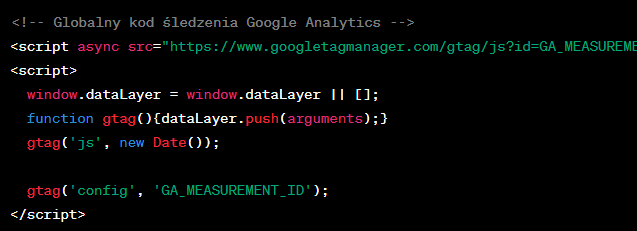Tracking and understanding user behavior on a website is not just a luxury, but a necessity. This is where Google Analytics 4 – a tool that allows you to gain deep insights into your website traffic – enters the scene. However, for this tool to work, you need Google Analytics code. We’ll look at the role and importance of Google Analytics code and how to implement it to gain valuable data and information about your site.

Earn more by optimizing your internet marketing
I will prepare an action strategy and, together with my team, implement it for you.
The Role of Google Analytics Code:
Google Analytics code is a piece of JavaScript code that is placed on every subpage of your website. Its main purpose is to collect data on user behavior on your site, such as the number of visits, traffic sources, time spent on the site, navigation paths and much more. With this data, you can understand exactly how users find their way around your site and what actions they take.
What does the Google Analytics code look like?
Below is a sample Google Analytics code with an explanation of its various elements:

In the code above, “GA_MEASUREMENT_ID” stands for the unique GA (Google Analytics) measurement identifier you get when you register and configure your property in Google Analytics.
Code Elements:
- <script async src=”https://www.googletagmanager.com/gtag/js?id=GA_MEASUREMENT_ID”></script>: This is the URL to the Google Tag Manager library that loads the Google Analytics tracking script. Replace “GA_MEASUREMENT_ID” with your own GA measurement ID.
- window.dataLayer = window.dataLayer || [];: Creates an array of data for the Google Tag Manager data layer. This is used to provide various information to Google Analytics.
- function gtag(){dataLayer.push(arguments);}: Defines the gtag function, which is used to pass data to the Google Tag Manager data layer.
- gtag(‘js’, new Date());: Indicates that the tracking script has been loaded.
- gtag(‘config’, ‘GA_MEASUREMENT_ID’);: Configures tracking for the specified GA_MEASUREMENT_ID property.
Before pasting this code into your site, you must register your site with Google Analytics and obtain a unique measurement identifier (GA_MEASUREMENT_ID). This will allow you to track and analyze user behavior on your website.
Google Analytics Code Implementation:
- Registration and account creation: If you don’t already have a Google Analytics account, register and create a new account on the platform Google Analytics .
- Create properties and views: After logging in, create a new property for your site and configure a corresponding view that includes only data from your site.
- Tracking code download: After configuring your properties and views, Google Analytics will provide you with a unique tracking code in the form of a JavaScript snippet.
- Placing the code on the page: Enter this code before closing the tag on each subpage of your site. This will make it possible to track traffic on each subpage.
Stay up to date with SEO news!
Sign up for the newsletter
Benefits Associated with Google Analytics Code:
- Understanding user behavior
With the collected data, you can find out which pages are the most popular, which traffic sources bring the most visits, and how long users stay on the site.
- Monitoring the effectiveness of marketing campaigns
You can track which marketing campaigns are producing the best results and conversions, allowing you to adjust and improve your marketing strategy on an ongoing basis.
- Site optimization
Based on page abandonment data, areas can be identified that need to be optimized and user experience improved.
Summary
Google Analytics code is a key tool that helps you understand your website traffic. By monitoring and analyzing data, you can make more informed decisions about content, optimization and marketing strategies. Implementing Google Analytics code is relatively simple and provides many benefits that can contribute to the success of your website online.











